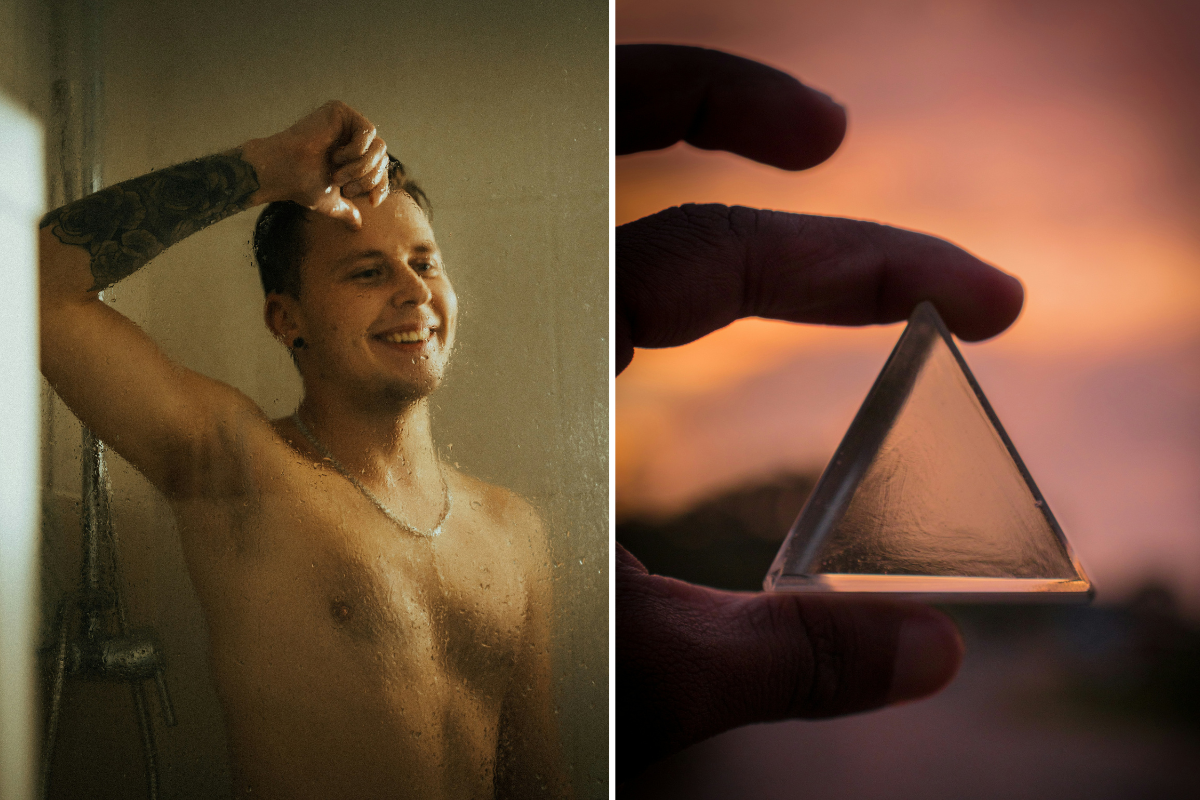Husband demonstrates 'Triangle' showering technique to his wife and guys, we need to talk
The horror!

It's long been known that women, on average, take longer showers than men. The disparity isn't too large, just a minute or two overall, but it indicates there is a difference between how men and women are approaching their bathing hygiene. Now we know why... even if wish we didn't.
Brit Richards recently asked her husband about his shower routine on a whim of curiosity. After he explained it, she whipped out her phone in disbelief and asked him to tell her again while she recorded. Other people were going to need to see this to believe it.
"I'm just so upset," she says jokingly in the intro to the video. "I found out how my husband washes his body in the shower."
A caption overlaying the video reads: "PLEASE HELP. THIS CAN NOT BE HOW MEN SHOWER."
What's got Brit so freaked out? The pantomimed routine starts off well enough, with John scrubbing his beard and scalp with soap. OK, cool. But then we move onto the body, and, well, you'll just want to watch. Or, actually, maybe you don't.
@britforreal “Mom, I’m scared. Can you come pick me up?” #men #husband #shower #help
Brit reacts in horror as her husband demonstrates that he washes what he calls "The Triangle" (an area that encompasses the groin and lower belly, basically) and then the "AMEX" (don't make me explain it. You watched the video, right?). And then... that's it.
Sure, we've covered the most important bits. But the thoroughness of John's routine definitely leaves a lot to be desired.
"You don't even wash your pits?" she asks him. "Sometimes," he says.
"You don't round the corners of your cheeks and you sit on public toilets? ... You've never washed your legs or feet?" The answer is extremely unfortunate.
Brit ends the video by telling him, tongue-in-cheek, of course, "You can't live here anymore."
John takes the criticism in stride and with a laugh, but the viral video's three million viewers are raising important questions.
To put it bluntly, women who saw Brit's video were absolutely horrified:
"Girl you didn't realize his showers were 20 seconds long?" one user asked.
"EVERY INCH NEEDS TO BE WASHED. EVERY INCH."
"You need to take showers together to supervise."
"BRB going to go talk to my teenage boys…I’m not about to raise a man that does this."
The roasts just kept coming, to the point that Brit started to feel a little bad for publicly putting her husband on blast. "POV: You told the Internet that your husband does the triangle wash in the shower and now millions of people are roasting him in your comment section and its actually all your fault," she captioned a follow up video. Woops!
John may be the unwitting face of the 'Triangle Wash' movement, but he's definitely not the only one. Commenters had plenty to say about that, too:
@britforreal Replying to @Mama I’m sorry babe, but 2025 isn’t gonna be your year. #marriage #shower #help #sos
"You are not alone! I even saved your video to show my husband because apparently washing “parts” is all he does too 🙄🤣.. it’s been an argument for years!"
"My husband takes like THE shortest showers and I’m so nervous to have this conversation with him! My anxiety can not"
"Yup I broke up with a guy after I seen the way he "washed" himself."
My theory on why so many men seem to be lacking in basic hygiene and grooming? It's because they weren't taught anything growing up outside of the bare basics, and then they were conditioned to think anything more than that was 'girly'. There are lot of hygiene and hygiene-related tasks that are considered feminine, like: Washing your face, moisturizing, taming your eyebrows, trimming your nails, exfoliating, wearing chapstick, and more. It stands to reason that putting too much effort into smelling good, being clean, and grooming our most sensitive areas could be interpreted as "unmanly."
A 2022 review of survey data interestingly found that more egalitarian countries, or countries where there was greater social equality between sexes, tended to see a smaller difference between how men and women approached hygiene. Less sex equality was associated with a greater difference in hygiene norms between men and women. So there's plenty of evidence that our gendered hygiene habits are created, at least in part, by our surroundings and not inherently embedded in our DNA.
Guys, I know that our culture has instilled some toxic beliefs in us, but we've just got to do better. We need to wash our pits and feet and, occasionally, wash the grime and oil from our faces properly. It's the least we can do, if not for ourselves, then for our partners. Being a little stinky and rough around the edges might have been cool in the Wild West, but they invented body wash for a reason.






 Rihanna Nails GIF
Rihanna Nails GIF A photo of Helen and Bill in their uniformsImages provided by Drew Coyle
A photo of Helen and Bill in their uniformsImages provided by Drew Coyle The map provided by Helen to Bill@crewdoyle/
The map provided by Helen to Bill@crewdoyle/ Helen and Bill, happy and and content, and oh so in love. Image from Drew Coyle
Helen and Bill, happy and and content, and oh so in love. Image from Drew Coyle Good luck trying to catch a gazelle.
Good luck trying to catch a gazelle. Chickens will eat just about anything.
Chickens will eat just about anything. There's actually a big difference between horses and zebras besides just the stripes.
There's actually a big difference between horses and zebras besides just the stripes. A photo of a portable carbon monoxide detector from Amazon
A photo of a portable carbon monoxide detector from Amazon


